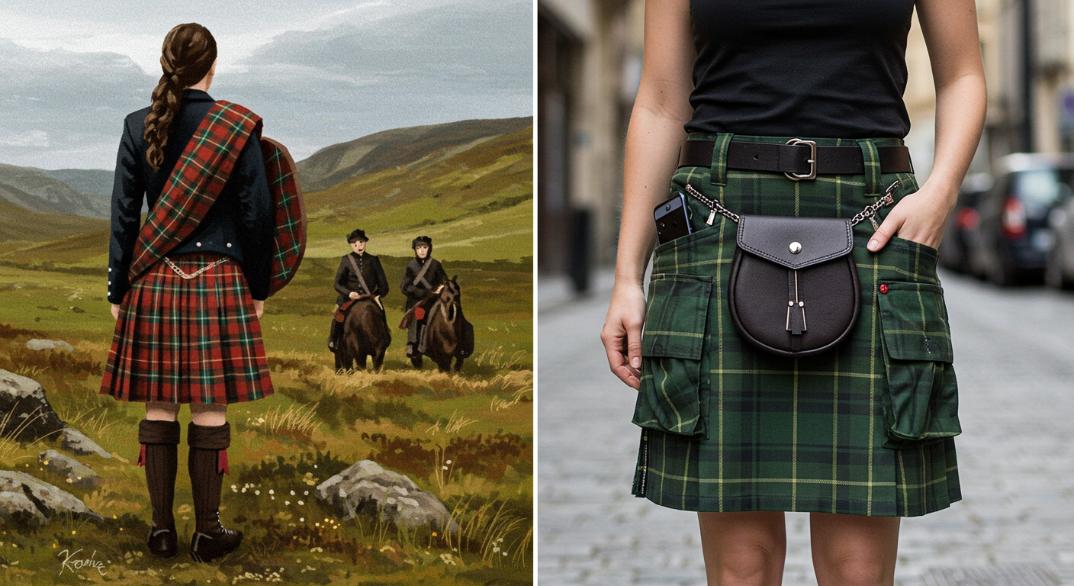A Brief History of Kilts: From Traditional to Modern Women’s Utility Kilts

Kilts are more than just garments—they're symbols of heritage, culture, and identity. From their origins in the rugged Scottish Highlands to their modern interpretations, kilts have undergone a fascinating evolution. Today, they are worn for traditional events and have found a place in everyday fashion through modern adaptations like womens utility kilt. This blog takes you through the history of kilts, their transition from traditional wear to utility kilts, and how they have become a versatile choice for women seeking both style and practicality.
1. The Origin of Kilts: Scotland's National Symbol
Kilts, which originated in the Scottish Highlands in the 16th century, have a long history. The earliest form was the Great Kilt (or Feileadh Mòr), a long piece of cloth typically made of wool that was worn around the body to protect against the harsh Highland weather. This versatile garment could also be worn as a cloak or blanket, serving both functional and aesthetic purposes.
Tartan Patterns and Clan Identity
One of the most iconic features of traditional kilts is their tartan pattern. Different clans used unique tartans to distinguish their family lineage and identity. These patterns were woven into the fabric, visually connecting to one's heritage. The tartan represented pride in one's clan and acted as a symbol of loyalty and unity.
2. The Evolution of Kilts in the 18th and 19th Centuries
The Transition to the Small Kilt
By the 18th century, the large, bulky Great Kilt evolved into a more streamlined version known as the Small Kilt (Feileadh Beag). This design was more practical, consisting of only the bottom portion of the Great Kilt. The Small Kilt was pleated and belted at the waist, making it easier to wear during battle or daily activities.
Kilts in the Military and Rebellion
Kilts gained significant cultural importance during the Jacobite uprisings, where Scottish clans fought to restore the Stuart monarchy. The kilt became a symbol of rebellion and Scottish pride. After the defeat of the Jacobites in 1746, the British government imposed the Dress Act, banning the wearing of kilts and tartans in an attempt to suppress Scottish culture. After the ban in 1782, kilts experienced a resurgence, especially during the Romantic period when there was a renewed interest in Scottish history and traditions.
Victorian Influence and Cultural Revival
Kilts became more formalized in the 19th century due to Queen Victoria's fascination with Scottish culture. She and Prince Albert popularized kilts as formal wear, making them a staple in high-society events. By this time, kilts were no longer just functional garments—they had become a symbol of national pride and were often worn at special occasions and parades.
3. Modern Adaptations of Traditional Kilts
Kilts in Contemporary Ceremonies
In modern Scotland, people wear kilts during weddings, Highland games, and other ceremonial events. Traditional kilts remain a marker of cultural pride, with many Scotsmen donning them to honor their heritage.
Kilts Beyond Scotland
Men and Women utility kilts influence spread beyond Scotland, becoming a global fashion statement. Designers worldwide have incorporated elements of kilts into their collections, blending traditional pleats and tartans with modern cuts and fabrics.
The Birth of Utility Kilts
As fashion evolved, so did the functionality of kilts. The utility kilt emerged as a modern interpretation of traditional kilts, designed with practicality. Unlike traditional kilts, utility kilts feature pockets, adjustable waistbands, and durable fabrics, making them suitable for various activities such as hiking, festivals, and daily wear.
4. The Rise of Women's Utility Kilts
Historically, kilts were considered menswear, but as fashion norms evolved, women began embracing them too. The development of women's utility kilts signaled a shift toward gender inclusivity and functionality in fashion. Today's utility kilts for women provide comfort, versatility, and practicality, making them ideal for casual outings and active lifestyles.
Why Women Love Utility Kilts
- Freedom of Movement: The pleated design allows unrestricted movement, making utility kilts perfect for outdoor activities.
- Functional Features: Pockets, adjustable straps, and durable materials cater to women who value practicality.
- Stylish Appeal: Utility kilts blend traditional elements with contemporary design, making them easy to style for various occasions.
5. Key Features of Modern Women's Utility Kilts
a) Practical Design
Unlike traditional kilts, utility kilts are equipped with functional details like large pockets, belt loops, and sturdy fasteners, making them more practical for everyday wear.
b) Versatility
Women's utility kilts are versatile enough to be worn in casual, semi-formal, or outdoor settings. They pair well with different tops, footwear, and accessories, allowing women to customize their look.
c) Durability and Comfort
Utility kilts are typically made from fabrics like cotton, polyester, or denim, providing durability without compromising comfort. Some even come in waterproof or weather-resistant materials, making them suitable for outdoor adventures.
6. Kilts in Modern Fashion and Pop Culture
Kilts have entered global fashion, with designers incorporating tartans and pleated skirts into contemporary outfits. Celebrities and influencers have played a role in bringing kilts into the mainstream, further blurring the line between traditional and modern styles. Unisex and utility kilts have gained popularity, appealing to people across genders who appreciate the balance of fashion and functionality.
7. The Cultural Significance of Kilts Today
Despite their modern adaptations, kilts remain an essential part of Scottish heritage. They symbolize pride, history, and identity and continue to be worn at national events and family gatherings. Utility kilts honor this legacy by preserving key design elements while making kilts more accessible and functional for today's world.
Conclusion
From their origins in the Scottish Highlands to their contemporary utility-focused designs, kilts have evolved while maintaining their cultural significance. Women utility kilt represent the perfect blend of tradition and innovation, offering style and practicality. As kilts adapt to modern needs, they remain a timeless symbol of heritage. Whether you're honoring tradition or seeking a practical outfit, utility kilts provide the perfect option for today's woman. Explore the variety of modern kilts and find one that fits your unique lifestyle.


